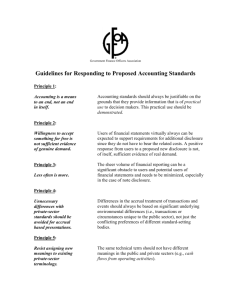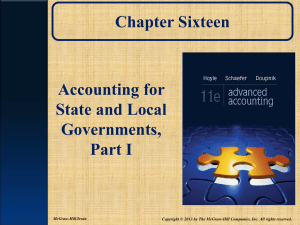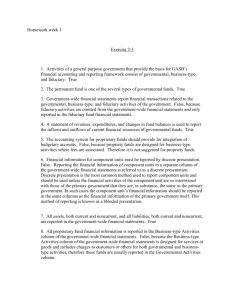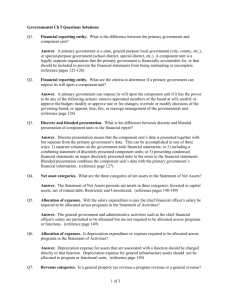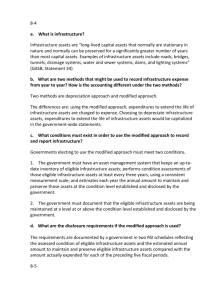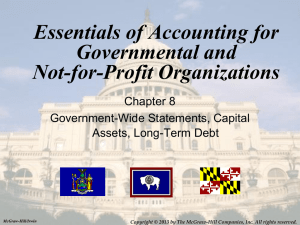Government-Wide Statements
advertisement
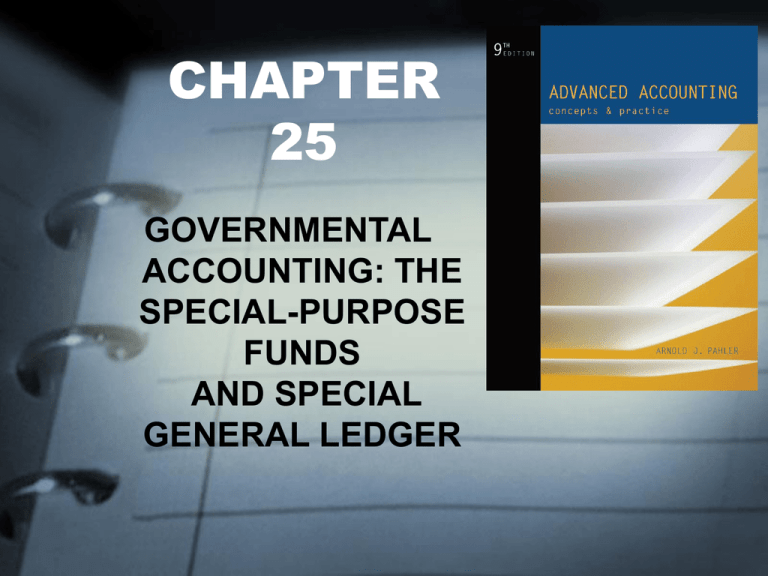
CHAPTER 25 GOVERNMENTAL ACCOUNTING: THE SPECIAL-PURPOSE FUNDS AND SPECIAL GENERAL LEDGER FOCUS OF CHAPTER 25 • • • • • The Remaining Governmental Funds The GCA-GLTL General Ledger The Proprietary Funds The Fiduciary Funds Financial Reporting to the Public: General-Purpose Financial Statements THE GOVERNMENTAL FUNDS: SPECIAL REVENUE FUNDS (#2 of 5) • Purpose: To account for the proceeds of specific revenue sources that are legally restricted to expenditure for specific purposes—excluding inflows for: – Capital projects and Expendable trusts. • Inflows: Usually from specific taxes or nontax sources not directly related to services provided. • A General Fund “clone”—same structure. THE GOVERNMENTAL FUNDS: CAPITAL PROJECTS FUNDS (#3 of 5) • Purpose: To account for the proceeds of financial resources that are to be used for the acquisition or construction of MAJOR CAPITAL FACILITIES—other than: – Those financed by • Proprietary Funds and • Trust Funds THE GOVERNMENTAL FUNDS: CAPITAL PROJECTS FUNDS (#3 of 5) • A temporary fund—at completion of the project: – The fund is closed and – The facility ’s cost is recorded as a capital asset in the GCA-GLTL g/l. – Costs incurred during construction are charged to expenditures (outflows). – Inflows: Bond sales and transfers from the General Fund. THE GOVERNMENTAL FUNDS: DEBT SERVICE FUNDS (#4 of 5) • Purpose: To account for the servicing of debt initially recorded as a liability in the GCA-GLTL g/l. • “Servicing of Debt” defined: The payment of (1) interest and (2) debt principal at maturity. • Unusual Features: – Interest is not accrued until the due date. – Principal payments are not recorded as liabilities until the due date. SPECIAL ASSESSMENTS • Special Assessments: Assessments made against properties that directly benefit from improvements: – Examples: Sidewalks, street lighting. • Special Assessment Bonds are usually issued to pay for the improvements. – All construction activity takes place in a Capital Projects Fund. SPECIAL ASSESSMENTS • Bond Repayment: Assessees pay taxes over several years to pay off the bond issue. • Special Assessment Debt may or may not have the backing of the governmental unit in the event of default. • Special Assessment Debt (SAD) Categories: – SADs With Government Commitment. (This is the usual situation.) – SADs Without Government Commitment. SPECIAL ASSESSMENTS • SADs With Government Commitment: – A Debt Service Fund is used to account for: • All collections from assessees. • All payments to bondholders. – The bond liability is recorded in the GCAGLTL g/l. – Unique Item: The entire tax assessment is recorded as Property Tax Receivables— the noncurrent portion is Deferred Revenues. SPECIAL ASSESSMENTS • SADs Without Government Commitment: – An Agency Fund is used to account for: • All collections of property taxes from assessees. • All payments to bond holders. • No liability is recorded in the GLTDAG. – The governmental unit is viewed merely as an agent for the assessees and the bondholders. THE GCA-GLTL GENERAL LEDGER • Purpose: Accounts for capital assets (at historical cost) and debt not accounted for in: – Enterprise Funds, Internal Service Funds, or Trust Funds. • Not a fund—it has no cash for paying liabilities. • A self-balancing set of accounts. GENERAL CAPITAL ASSETS • Categories of Assets: – Land – Buildings – Improvements other than buildings – Equipment – Construction work in progress (being performed by Capital Projects Funds) – Infrastructure assets (see next slide) GENERAL CAPITAL ASSETS: Infrastructure Assets • Capitalization is mandatory for public domain or “infrastructure” capital assets such as: – Streets and roads – Sidewalks – Bridges and tunnels – Water & sewer systems – Lighting systems GENERAL CAPITAL ASSETS: Infrastructure Assets • Infrastructure Assets: – Long-lived capital assets that normally are: • Stationary in nature • Normally can be preserved for a significantly greater number of years than most capital assets. GENERAL CAPITAL ASSETS: Postcapitalization Periods • Depreciation is mandatory—except for certain infrastructure assets: – Depreciation Expense is never reported in the operating statement of governmental funds. – It is reported only in the two government-wide statements. • Sales of Assets: Record proceeds as OTHER FINANCING SOURCES in General Fund. INFRASTRUCTURE ASSETS: Depreciation • Noneligible Infrastructure Assets: – Must be depreciated. (See following slide regarding eligible infrastructure assets.) INFRASTRUCTURE ASSETS: Depreciation • Eligible Infrastructure Assets : – Need not be depreciated. – Defined: Assets being (1) managed using an asset management system having certain characteristics (described in GAS 34) and (2) preserved approximately at or above an established and disclosed condition level. • Condition assessments must be performed at least every 3 years. GENERAL LONG-TERM LIABILITIES • Long-term debt that is not properly shown in Proprietary Funds or Trust Funds. GLTL includes: – DEBT issuance liabilities having a maturity date of more than one year at the time of issuance (these are borrowings). – NONDEBT issuance liabilities that would not “normally be liquidated with expendable available financial resources” (e.g., a lawsuit liability to be paid in 3 yrs.). GENERAL LONG-TERM LIABILITIES • Examples of Debt Recorded in GCA-GLTL g/l: – General obligation bonds (usually issued to pay for capital projects). – Claims and judgments. – Compensated absences (vacation & sick pay). – Unfunded pension contributions. – Capital leases payable. – Special assessment debt having government commitment (explained earlier). GENERAL LONG-TERM DEBT LIABILITIES • Consequences of Reporting “Nondebt Issuance Liabilities” in the GCA-GLTL g/l: – It enables governments to magically conceal whether they are living within their means at the fund-based reporting level. – It results in the fund-based “operating statement” being a “Statement of ALL of the Revenues and SOME of the Costs Incurred This Period.” GENERAL LONG-TERM DEBT LIABILITIES • BAD NEWS: Many governmental units have tons of nondebt issuance liabilities that will have to be paid by future generations (which may find it quite burdensome or impossible to pay). GENERAL LONG-TERM DEBT LIABILITIES • GOOD NEWS: GAS 34 (issued in 6/99) requires “government-wide financial statements” that measure the flow of economic resources on the accrual basis. Such statements reveal: (1) the cost of providing services. (2) the change in the financial condition. GENERAL LONG-TERM DEBT LIABILITIES • Liquidation of GLTL: – Debt Issuance Liabilities: At the maturity date, the liability is transferred to a Debt Service Fund. – Nondebt Issuance Liabilities: At the payment date, the liability is transferred to the General Fund. Note that GLTL is not removed from the GCA-GLTL g/l when it becomes a current liability (due within 12 months). THE GOVERNMENTAL FUNDS: PERMANENT FUNDS (#5 of 5) • Permanent Funds: – Accounts for endowment-type situations in which: • Only the endowment’s earnings can be used for purposes that support the reporting government’s programs. • Benefits the reporting government or its citizenry. THE PROPRIETARY FUNDS: INTERNAL SERVICE FUNDS • Purpose: To account for activities that provide services solely to other departments. • Manner of accounting parallels that of commercial businesses (accrual basis & measurement of flow of economic resources). – Balance sheet reports Long-Term Debt. THE PROPRIETARY FUNDS: ENTERPRISE FUNDS • Purpose: To account for activities that provide services primarily to the public. • Examples: Gas, electric, water utilities. • Manner of accounting parallels that of commercial businesses (accrual basis & measurement of flow of economic resources). – Balance sheet reports Long-Term Debt. THE FIDUCIARY FUNDS • Two categories (four funds) exist: – Agency Funds. – Trust Funds: • Pension (and other employee benefit) Trust Funds • Investment Trust Funds • Private-Purpose Trust Funds THE FIDUCIARY FUNDS: AGENCY FUNDS • Purpose: To serve as conduits for the transfer of money—purely custodial in nature. • ASSETS ALWAYS EQUAL LIABILITIES. A = L • The following items do not exist: – A fund balance/equity – An operating statement THE FIDUCIARY FUNDS: TRUST FUNDS • Purpose: To account for the investing and using of money in accordance with stipulated provisions of trust indenture agreements or statutes. • Pension (and other employee benefit) Trust Funds. • Investment Trust Funds (created by GAS 31). • Private-Purpose Trust Funds. PRIVATE-PURPOSE TRUST FUNDS • Accounts for property held under trust arrangements in which: – Both the principal and income benefit: • Individuals • Private organizations • Other governments FINANCIAL REPORTING TO THE PUBLIC: The CAFR • The Comprehensive Annual Financial Report (CAFR). Includes: – Government-wide statements (2) – Fund-based statements (7) Government-Wide Statements • Two major statements that: – Are presented on the accrual basis. – Measure the flow of economic resources (same measurement flow as in commercial accounting). Government-Wide Statements • These two statements are the: – Statement of Net Assets (includes all GCA and GLTL). – Statement of Activities (includes depreciation expense). • These two statements are presented in addition to the Fund-Based Financial Statements (7 of them). Government-Wide Statements • The two government-wide statements enable assessment of whether: – Current-year citizens paid for the services they received in the current year, or if the costs of services were shifted to future-year citizens. Government-Wide Statements – A government’s financial position has improved or deteriorated as a result of the year’s operations. Government-Wide Statements • Each of the two government-wide statements must distinguish between: #1 – Governmental activities and businesstype activities of the primary government. #2 – The total primary government and its discretely presented component units by reporting each in separate columns. Government-Wide Statements • Fiduciary activities are: – Excluded from the government-wide statements if their resources are NOT available to finance the government’s programs. Government-Wide Statements • IMPORTANT FEATURES of the government-wide Statement of Net Assets: #1 – Reports all “general capital assets”— including infrastructure. #2 – Reports all debt—including GLTL. Government-Wide Statements • IMPORTANT FEATURES of the government-wide Statement of Net Assets (cont.): #3 – Reports net assets in 3 categories: #1 • Invested in capital assets, net of related debt #2 • Restricted #3 • Unrestricted Government-Wide Statements • IMPORTANT FEATURES of the government-wide Statement of Net Assets (cont.): #4 – In general, interfund balances (loans, advances, and due to and due from accounts) are eliminated. Government-Wide Statements • IMPORTANT FEATURES of the government-wide Statement of Activities: #1 – Presented in at least the same level of detail provided in the governmental fund statements (generally, expenses and program revenues by function—e.g., public safety, public health, and recreation). Government-Wide Statements • IMPORTANT FEATURES of the government-wide Statement of Activities: #2 – Format must report expenses reduced by program revenues—results in a measurement of “net (expense) revenue” for each of the government’s functions. Government-Wide Statements • IMPORTANT FEATURES of the governmentwide Statement of Activities (cont.): – Program expenses include all direct #3 expenses. • Depreciation expense that can specifically be identified with a function is reported as a direct expense. • Allocated overhead and other indirect expenses to individual programs are presented in a separate column. Government-Wide Statements • IMPORTANT FEATURES of the government-wide Statement of Activities (cont.): #4 – Reports extraordinary items (items beyond control of mgt.) separately. #5 – Reports special items (items within the control of mgt.) separately. Government-Wide Statements • IMPORTANT FEATURES of the government-wide Statement of Activities (cont.): #6 – In general, interfund activity is eliminated: • Interfund services provided and used. • Interfund transfers. • Other interfund activity. Fund-Based Statements • Purpose of fund-based statements: – These statements show the short-term performance of individual funds using the same measures that governments use to manage their money. Fund-Based Statements • A SHARPENED FOCUS: – Must report information about the most important funds—the “major funds” (including the General Fund). Fund-Based Statements • Major funds are those whose revenues, expenditures/expenses, assets, or liabilities are at least: – 10% of the total for their fund category or type (governmental or enterprise) and – 5% of the aggregate amount for all governmental and enterprise funds. Fund-Based Statements – Nonmajor funds are: • Aggregated and • Reported in a separate column (labeled “all other funds”). Fund-Based Statements • IMPORTANT FEATURES of the fundbased statements #1 – Must present two summary reconciliations that show the interplay between the two types of statements. • Both types of statements together constitute “an integrated set of statements.” Fund-Based Statements • IMPORTANT FEATURES of the fundbased statements (cont.): – In general, interfund activity will be #2 reported separately: • Interfund services provided and used. • Interfund transfers. • Other interfund activity • Interfund open balances. Fund-Based Statements • IMPORTANT FEATURES of the fundbased statements (cont.): #3 – Internal Service Funds are aggregated and presented in a separate column on the proprietary fund statements. Fund-Based Statements • IMPORTANT FEATURES of the fund-based statements (cont.): – Proprietary Funds: #4 • Statement of Net Assets (or Balance Sheet): –Displays net assets using the same categories used in government-wide statements. –Distinguishes between restricted and unrestricted assets. Fund-Based Statements • IMPORTANT FEATURES of the fundbased statements (cont.): #4 – Proprietary Funds (cont.): • Statement of Revenues, Expenses, and Changes in Fund Net Assets (or Equity): –Must distinguish between operating and nonoperating revenues and expenses. Fund-Based Statements • IMPORTANT FEATURES of the fund-based statements (cont.): #4 – Proprietary Funds (cont.): • The all-inclusive change in fund net assets includes (1) capital contributions; (2) contributions to term and permanent endowments, (3) special items, (4) extraordinary items, and (5) transfers. • Cash flow statement must use the direct method (interest expense is financing—not operations as in private sector). Required Supplementary Information (RSI) • RSI includes: – Budgetary comparison statements for the General Fund and each major Special Revenue Fund. • Use both original budget and • Any amended budget. – Management’s discussion and analysis (the MD&A). End of Chapter 25 Time to Clear Things Up—Any Questions?
